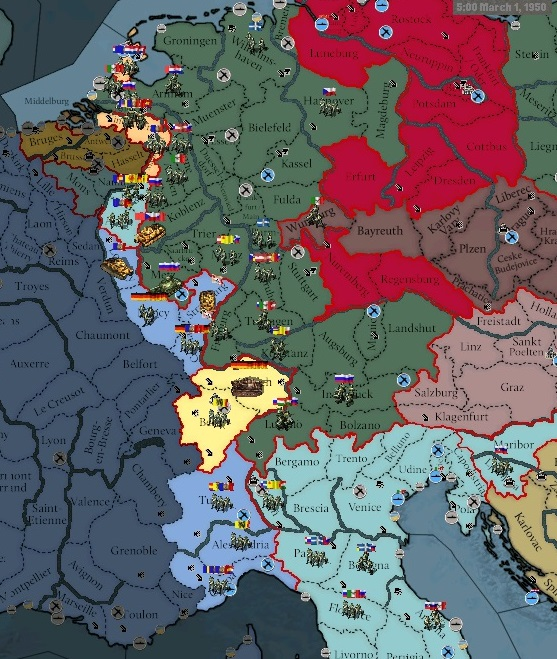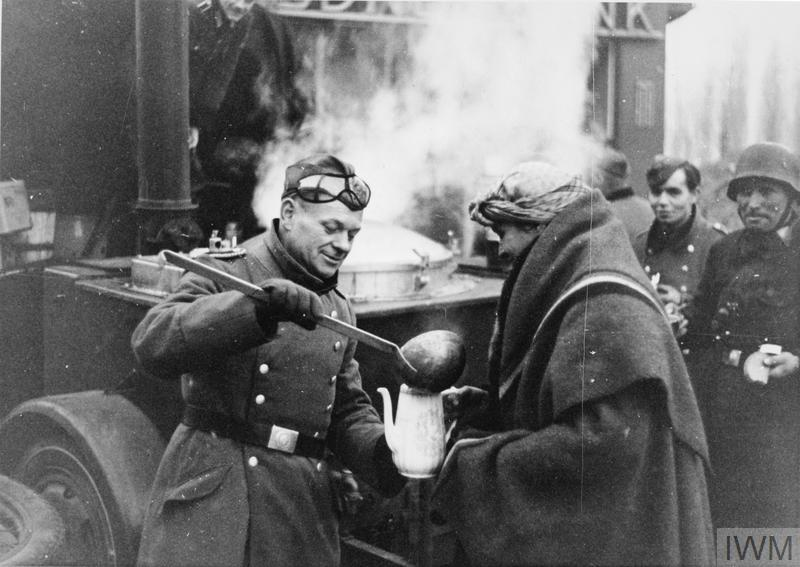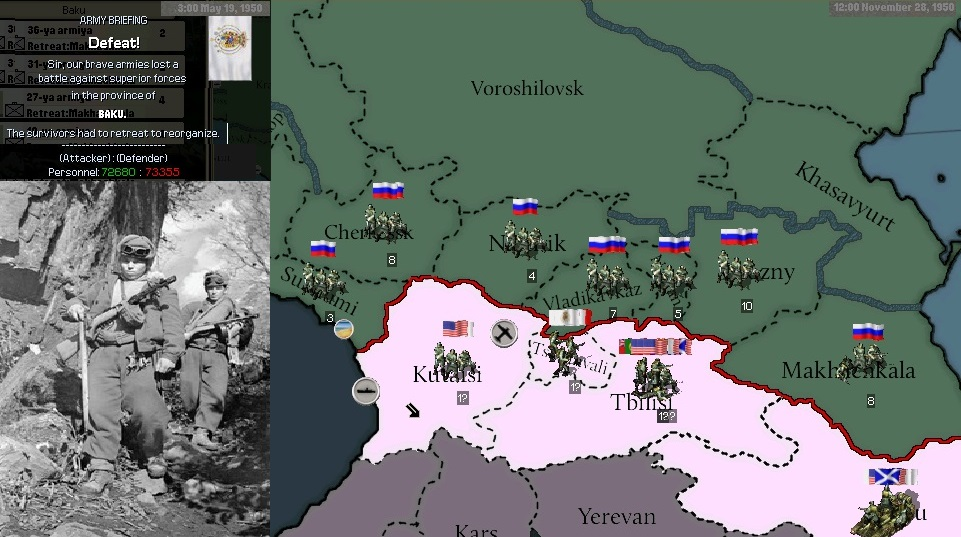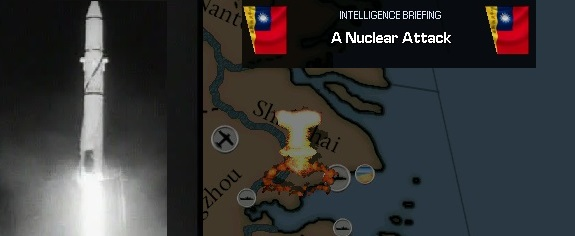1949 – The Destroyer of Worlds
1949 – The Destroyer of Worlds
In the six weeks after their declaration of war, the Serbs achieved huge successes against the Eurasian League – pouring across lightly defended borders and benefiting from the support of American air power. In Asia Minor, they moved to occupy the territories of Crusader Anatolia while supporting Allied offensives towards the Caucuses. In the Balkans they swarmed into Moldavia and were only halted at the key port of Odessa, where the Russians were able to scramble reinforcements to hold them back. In Pannonia, they captured Budapest and brought the long-time Russian satrapy to the brink of defeat. However, even during this period of general advance there were some setbacks. In their Balkan heartland, the Greeks held firm and resisted all attempts to push into their territory, while in west Russian tanks were already pushing past the pre-war boundary and were able to prevent the fall of Pannonia.

On the western front, the redeployment of troops to other frontiers made any Russian offensive operations in the spring of 1949 completely untenable. The momentum the Eurasian League had built up in the region over the preceding months was quickly sucked away and put into reverse. Over the course of April and May 1949 the Russians engaged in an orderly retreat from the Low Countries, the key Italian cities of Turin and Milan were lost after bitter battles and the Allies conducted a successful landing in northern Jutland to force a further redistribution of forces. Defeats in Europe concerned the Russian leadership far more than its reverses in other sectors, its military strategists having staked everything on achieving victory on this most important of battlefields. With this in mind, Feodor Golikov approved the deployment of Russia’s greatest secret weapon.
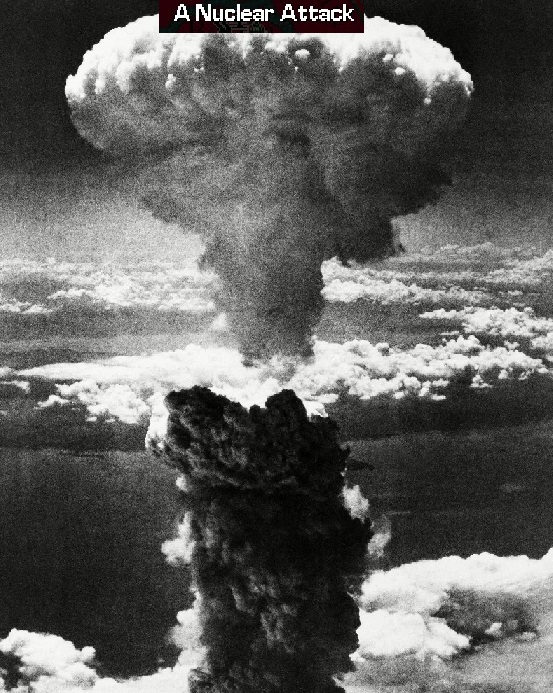
Since conducting the very first atomic bomb test in January 1947, the Russian regime had been considering the best way to harness the new power they had uncovered. With the military situation worsening on every frontier in spring 1949, it was decided that they could wait no longer. On the 28th of May 1949 Russian aircraft dropped a nuclear bomb over the city of Stuttgart, a strong point in the Allied line in Western Europe and a key industrial centre for German military production. This single bomb destroyed the city and wiped out tens of thousands of lives in an instant, bringing the world into a new and terrifying age of nuclear warfare.
The destruction of Stuttgart horrified millions around the world and hardened a growing anti-Russian international consensus. Indeed, the United States took the bold step of announcing that henceforth, it would reject any possibility of a negotiated peace with Russia – only unconditional surrender, the destruction of the Radical regime and dismantlement of its empire would be acceptable.
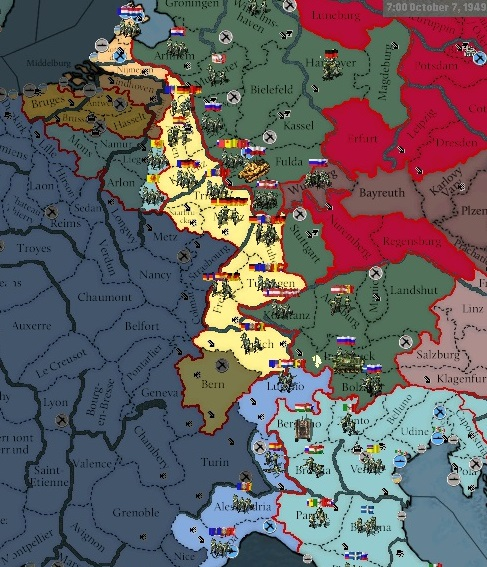
Nonetheless, nuclear warfare proved to be a tremendous military success. Having been on the back foot for the previous two months, the Russians regained the initiative and began to reverse Allied gains and push deeper into enemy territory – making use of nuclear strikes on two further occasion at Fulda and the Ruhr industrial hub of Essen to buttress their advance. Although they were able to secure key victories, and bring the German contingent of the Allied coalition in particular to the brink of breaking, their gains were somewhat underwhelming, with the Eurasians yet to cross the Rhine by October.
More rapid success was to be found in Eastern Europe. After the Serb invasion, the Russians had redirected many of their fastest moving and most effective units to counter their opponents. While the Serbs were able to make gains in the first weeks of their entry into the war, once these units reached the lines they quickly showed their superiority and began to roll back the Serbian invasion and drive deeply into their home territory. The situation was only worsened by the terror caused by the nuclear attacks in Germany – which shook civilian morale and military morale alike to the point of breaking and led to the Americans withdrawing the bulk of their aerial support in an effort to protect Western Europe from the threat of further nuclear attacks. Belgrade fell in mid June and Constantinople followed at the end of July with the Serbian empire surrendering in August.

Serbia was not the first country to be knocked out of the war in the aftermath of Stuttgart. In the Far East, Korea’s initial successes in pushing into Manchuria at the end of 1948 had very quickly become bogged down once Russian forces arrived to buttress their local allies in the region. Although they had failed to make the short work of the Koreans that they had expected, nonetheless through the first half of 1949 they made gradual progress – first recapturing their lost territory and then crossing into Korean Transamur. Confidence in Seoul was already buckling even before the Russian unleashed hellfire over Germany and within days a couple weeks of the destruction of Stuttgart the Koreans offered Russia a white peace, a deal Kiev quickly accepted.
Indeed, the Far East had emerged as a serious quagmire for the Eurasian League as Russia found China to be a formidable foe and its allied Khanates in the region utterly incapable of defending themselves from concerted attack. Although the Russians had celebrated their defence of Beijing through the autumn of 1948, the city fell in December that, proving to be a harbinger of a longer period of Russian retreat. On every part of the vast frontier between China and the Eurasian League, the Chinese held a decided numerical advantage. Invariably, the superior organisation and firepower of the Russians would allow them to initially repel attacks and hold the line, often for weeks and months, yet they lacked the resources to even contemplate offensive operations and were forced to consistently give up land – with the Chinese achieving particularly significant gains in Tibet and central Mongolia. The Russians could only hope that the fall of Korea would allow them to redeploy enough troops to stop the bleeding.

Back in Europe, the troublesome Northern and Middle Eastern fronts were consolidated through 1949. In the North, the arrival of reinforcements stopped the Allied advance in its tracks in early summer before counteroffensives in July and August recaptured Archangel and pushed the Allies all the way back to a stable front line in northern Finland and Karelia that held for several months. Indeed, by November 1949 the Eurasians were in a position to go on the offensive, with almost half a million soldiers concentrated on the Front they had achieved a clear numerical advantage.
To the south, Russian defeats in the Middle East, and Persian entry into the war, had led to a retreat towards a formidable Caucasian defensive line stretching from Baku to the Black Sea through Yerevan and Kars. This had proven impenetrable to the Allies for months, repulsing all attacks with ease and securing Russia from invasion from the south. After the defeat of the Serbian empire in August, both Russian and Allied forces had swarmed into the vacuum in Anatolia – dividing the territory between a Russian north and Allied south, with few major engagements between either side before the end of the year as both focussed on a battle of manoeuvre.
Last edited:
- 2


